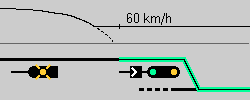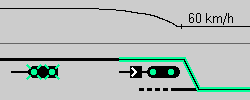


On lines with line speeds exceeding 75 km/h Entry Signals, Automatic Block Signals and Protection Signals are preceded by a Distant Signal (Danish: Fremskudt Signal, often abbreviated F-signal) unless they are advance signaled by the previous Main Signal. On lines with lower line speeds Distant Signals are only used where visibility of the Main Signal is otherwise insufficient. The Distant Signal informs the train of the indication of the following Main Signal but does not convey information on the state of the line between the Distant Signal and the following Main Signal.
Distant Signals are basically of 2 types, the 2-lamp type or the 3-lamp type. 2-lamp Distant Signals are installed on the approach to Automatic Block Signals or Protection Signals while 3-lamp Distant Signals are used on he approach to station Entry Signals. A 4-lamp variation of the 3-lamp signal is used in advance to station Entry Signals with a diverging Extended Proceed route (shown below for a route diverting towards the right). 2-lamp Distant Signals were previously installed also on the approach to station Entry Signals where either there was no Extended Proceed route through the station or speeds were low. Such signals still remain in operation:



Green lamps are omitted where the following Entry Signal cannot show a signal aspect requiring them:



Distant Signals only display flashing lights.
On lines permitting speeds up to 120 km/h, distant signals are placed 800 m before the Main Signal. Where line speeds exceed 120 km/h the Distant Signal is placed 1200 m before the Main Signal. Previously Distant Signals were placed only 400 m ahead of the Main Signal where line speeds were 100 km/h or lower and a number of such signals still remain. These signals are mostly 2-lamp signals.
Only two semaphore Distant Signals were still in service at the turn of the millenium, on the approaches to Borris station:

Semaphore Distant Signals were always located 400 m before the Main Signal.
 |
 |
 |
 |
|
|
X | X | X | X |
|
X | |||
|
X | X | X |
 |
 |
 |
 |
|
|
X | X | X | X |
|
X | X | ||
|
X | X |
 |
 |
 |
|
|
X | X | X |
|
X |
Until 1922 Distant Signals were applied as needed in braking distance of the Station Limits and in a few cases they were duplicated. From 1922 all Distant Signals were placed 400 m from their Main Signal and duplication was no longer used. Distant Signals became a requirement where line speed was beyond 70 km/h. Additionally, Approach Markers were introduced to warn of the upcoming Distant Signal and were located 1000, 800 and 600 m on approach to the Main Signal. The maximum speed on mainlines at the time was 100 km/h, and thus the 400 m plus the sighting distance of the Distant Signal was just sufficient for braking distances around 700 m:

Colorlight Distant Signal were introduced around 1930. In 1935 maximum speeds on some mainlines was raised to 120 km/h. The increased braking distances required the advance signaling distance to be increased and 800 m was chosen as the new distance. Distant Signals located 800 m on approach to their Main Signal were always colorlight signals and a 3-aspect colorlight Distant Signal was introduced for the approach to Entry Signals. The third aspect ("The following station Entry Signal shows Extended Proceed") was likely introduced to reassure the driver that the route ahead was indeed the Extended Proceed Route, i.e. the fastest route, through the station. The 3-aspect Distant Signal is shown here with the present-day - post 1944 - placement of Approach Markers:

The 3-aspect Distant Signals have always been located at least 800 m in advance of the Entry Signal.
Distant Signals on approach to stations with diverging through routes are generally placed following the same rules as the 3-aspect Distant Signal, i.e. at least 800 m in advance of the Entry Signal:

Distant Signals on approach to Automatic Block Signals or Protection Signals are 2-aspect signals (since the Automatic Block Signal cannot show "Extended Proceed"). They are generally placed following the same rules as 3-aspect signals:

On mainlines with line speeds exceeding 120 km/h (introduced 1986) the Distant Signals are placed 1200 m in advance of their Main Signal:

Advance signaling distance on lines with line speeds of 75 km/h is still 400 m and on those lines Entry Signals are only preceded by 2-aspect Distant Signals:

On lines with line speed 75 km/h or less the Distant Signal may be omitted provided there is sufficient sighting distance of the Main Signal.
 |
 |
 |
 |
 |
 |
 |
 |
 |
 |
 |
 |
 |
 |
 |
 |
 |
 |
Please note the difference between an Entry Signal at "Proceed at reduced speed" and "Extended Proceed at reduced speed":
- For "Proceed" the reduced speed is required from the Entry Signal itself, whereas
- For "Extended Proceed" the reduced speed is only required at the restriction itself.
By using the "Main Signal shows Extended Proceed" aspect the train can brake for the speed restriction later, as the "Extended Proceed Route" is unambiguous:
 |
 |
 |
 |
| [Back] | [Home] |